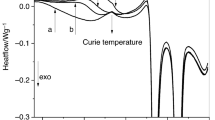Abstract
Thermodynamic parameters of defects (presumably, defective SiO molecules) in the network of amorphous SiO2 are obtained by analyzing the viscosity of the melt with the use of the Doremus model. The best agreement between the experimental data on viscosity and the calculations is achieved when the enthalpy and entropy of the defect formation in the amorphous SiO2 network are H d =220 kJ/mol and S d =16.13R, respectively. The analysis of the network defect concentration shows that, above the glass-transition temperature (T g ), the defects form dynamic percolation clusters. This result agrees well with the results of molecular dynamics modeling, which means that the glass transition in amorphous SiO2 can be considered as a percolation phase transition. Below T g , the geometry of the distribution of network defects is Euclidean and has a dimension d=3. Above the glass-transition temperature, the geometry of the network defect distribution is non-Euclidean and has a fractal dimension of d f =2.5. The temperature T g can be calculated from the condition that percolation arises in the defect system. This approach leads to a simple analytic formula for the glass-transition temperature: T g =H d /((S d +1.735R). The calculated value of the glass-transition temperature (1482 K) agrees well with that obtained from the recent measurements of T g for amorphous SiO2 (1475 K).
Similar content being viewed by others
References
B. I. Shklovskii and A. L. Efros, Electronic Properties of Doped Semiconductors (Nauka, Moscow, 1979; Springer, New York, 1984).
M. B. Isichenko, Rev. Mod. Phys. 64, 961 (1992).
M. I. Klinger, Phys. Rep. 165, 275 (1988).
I. Campbell, P.-O. Mari, A. Alegria, and J. Colmenero, Europhys. News 3/4, 46 (1998).
A. G. Hunt, J. Non-Cryst. Solids 274, 93 (2000).
K. Binder, J. Non-Cryst. Solids 274, 332 (2000).
N. N. Medvedev, A. Geider, and W. Brostow, J. Chem. Phys. 93, 8337 (1990).
A. V. Evteev, A. T. Kosilov, and E. V. Levchenko, Pis’ma Zh. Éksp. Teor. Fiz. 76, 115 (2002) [JETP Lett. 76, 104 (2002)].
R. H. Doremus, J. Appl. Phys. 92, 7619 (2002).
M. I. Ozhovan, Pis’ma Zh. Éksp. Teor. Fiz. 79, 97 (2004) [JETP Lett. 79, 85 (2004)].
M. I. Ojovan and W. E. Lee, J. Appl. Phys. 95, 3803 (2004).
J. W. Haus and K. W. Kehr, Phys. Rep. 150, 263 (1987).
G. Urbain, Y. Bottinga, and P. Richet, Geochim. Cosmochim. Acta 46, 1061 (1982).
G. Hetherington, K. H. Jack, and J. C. Kennedy, Phys. Chem. Glasses 5, 130 (1964).
N. M. Pavlushkin, Fundamentals of Sitalle Technology (Stroiizdat, Moscow, 1979) [in Russian].
H. Scher and R. Zallen, J. Chem. Phys. 53, 3759 (1970).
M. I. Ozhovan, Zh. Éksp. Teor. Fiz. 104, 4021 (1993) [JETP 77, 939 (1993)].
R. Bruning, J. Non-Cryst. Solids 330, 13 (2003).
Author information
Authors and Affiliations
Additional information
__________
Translated from Pis’ma v Zhurnal Éksperimental’no\(\overset{\lower0.5em\hbox{$\smash{\scriptscriptstyle\smile}$}}{l} \) i Teoretichesko\(\overset{\lower0.5em\hbox{$\smash{\scriptscriptstyle\smile}$}}{l} \) Fiziki, Vol. 79, No. 12, 2004, pp. 769–771.
Original Russian Text Copyright © 2004 by Ojovan.




